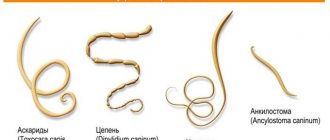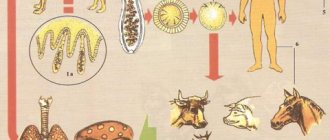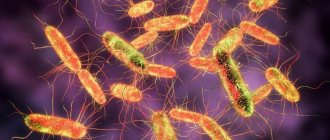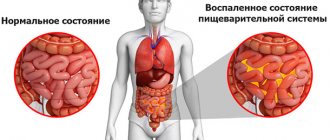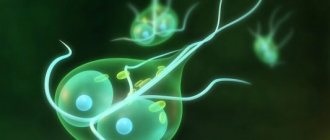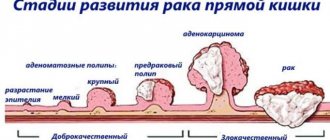Types of parasitic worms
Luminal worms are the most common.
They parasitize the intestines of humans and animals. Tissue helminths do not live in the gastrointestinal tract; they settle in other organs: lungs, muscles, brain, liver. A very common type of worm is roundworm. They are both tissue and luminal; they can settle both in the intestines and in the liver, lungs or heart. In biology, worms are divided into several classes:
- Nematodes (roundworms): roundworms, pinworms, filariae, trichinella, whipworms.
- Cestodes (tapeworms): tapeworm, echinococcus, pork and bovine tapeworm.
- Trematodes (flatworms): cat fluke (liver fluke).
How to understand that you have worms of one of the above varieties? To do this, you need to know all possible routes of transmission of the infection.
Many patients are interested in the question of how to understand that worms are coming out. Only luminal parasites from the intestine can be excreted in feces. Worms that live in other organs and tissues cannot exit through the gastrointestinal tract. It is important to remember that worm eggs cannot be seen with the naked eye, as they are microscopic in size. Only adults can be seen. They come out with severe infestation and anthelmintic therapy.
Let's look at what the most common intestinal parasites look like in human feces:
- Pinworms. These worms look like gray and white threads. Usually weakened or dead individuals, as well as fragments of the body of helminths, come out.
- Roundworms. These parasites very rarely leave the human body alive. Usually, after taking anthelmintic drugs, dead worms are excreted in the feces. This is a helminth 20-40 cm long with a pinkish body. Dead individuals are yellowish in color.
- Lentets. The segments of the parasite emerge, which look like white ribbons from 30 cm to 3 m long.
- Pork and bovine tapeworms. In the bovine tapeworm, only the segments are excreted with feces; they look like light-colored strips 1.6-3 cm long. The segments of the pork tapeworm do not crawl out and are not found in feces.
Decoding the results
Only the attending physician should interpret the analysis to identify parasites. But before visiting the doctor, if the patient has a form with the test result, he can understand the condition of his body himself. This is especially easy to do with regard to coprogram (stool analysis). Thus, if eggs or individuals of a parasite are detected in feces, the form will be marked “detected/identified”, and the type of parasite will be indicated below. If the patient’s stool is clean, the form will show “not detected.”
The test for enterobiasis can be negative or positive. That is, the research form will contain “-” or “+”.
As for ELISA (blood test for parasites), the result can be interpreted based on the antibodies detected in the blood sample. In particular, a laboratory assistant can identify the following immunoglobulins with the appropriate interpretation:
- The activity of IgM antibodies indicates recent infection (no more than 14 days),
- The activity of IgG antibodies indicates the development of immunity in the body and the chronic course of the pathology,
- IgE activity indicates the presence of a parasitic infection in the patient’s body.
In this case, the specialist will additionally evaluate the concentration of antibodies per blood volume, which will allow the doctor to assess the intensity of the parasitic infection and the activity of the helminth in the body.
Important: if the patient does not know where to get tested for parasites, then it is worth understanding that the attending physician refers the patient to one of the government or commercial laboratories. You can independently take tests only in the form of feces and scrapings in a commercial diagnostic and laboratory center. It is unlikely that blood will be taken for helminthic infestations without a referral from the patient. Or they will offer to do a full comprehensive analysis (blood and urine tests), which will cost a pretty penny.
What symptoms can parasites cause?
The blood test for worms is the most modern and accurate; it determines the presence of parasites with 95% accuracy. There are 20 types of worms common in our country, the carriers of which are 70% of the population. Infection of the body with helminths (worms) occurs through direct contact with the carrier or through objects on which they parasitize.
Infection of young children most often occurs through dirty hands, toys and through objects touched by a sick child. By parasitizing the human body, helminths poison it with the products of their vital activity and take away nutrients from food. Timely diagnosis and treatment are necessary in every case, because advanced forms of the disease and long-term infestation cause significant harm to health.
If you notice that your child has become lethargic and capricious, sleeps anxiously and grinds his teeth in his sleep, then these symptoms alone are enough to see a doctor. When obvious signs of infestation appear, such as itching and scratching of the anus, the appearance of worms in the feces, this means that the number of parasites in the body is critical and emergency treatment is necessary. In addition, there are pests that can only be detected by a special blood test.
You will have to undergo examinations to determine the presence and type of parasite, these include:
- stool analysis;
- smear;
- analysis for dysbacteriosis;
- general blood analysis;
- blood for ELISA.
A stool examination is necessary to detect worm eggs and determine the type of infection. For the same purposes, a smear or scraping is taken around the anus. These tests give a significant error, they have to be taken 3 times with a break of several days, and the result largely depends on the qualifications of the laboratory technician. An analysis for dysbiosis will show changes in the intestinal flora and inhibition of normal E. coli, which is typical for helminthic infestations.
The most complete picture is provided by a blood test. If you complain of poor health or health problems, a general blood test is first taken.
Increased hemoglobin, ESR levels, increased eosinophils and, less commonly, anemia - all these are symptoms of damage to the body.
With the help of a modern blood test for helminths (ELISA), not only the presence of worms, but also their type is detected with high accuracy. This is especially important for detecting infections not detected by stool or smear tests.
ELISA detects a wide range of infectious lesions caused by various parasites.
A blood test for worms reveals specific antibodies in the blood and antigens to various types of pests.
With this study you can establish:
type of helminth;
- ability to reproduce;
- amount in the body.
You will have to donate blood for helminths if persistent colds, brittle hair and nails, constipation and allergic skin rashes, and depression are added to the main symptoms. Even if standard tests show the absence of infection, ELISA will almost always provide a comprehensive picture and can confirm the diagnosis.
The main indications for the test are: suspicion of invasion, increased leukocytosis, preventive examination of workers, epidemiological situation. Using this blood test for worms, you can detect all types of pests living in the body, their negligible quantities, accurately determine the class of immunoglobulins and describe the dynamics of the process.
Blood is taken from a vein on an empty stomach, and you are allowed to drink still water. At least 8 hours should pass from the last meal; it is recommended not to eat fatty, salty or spicy foods for two days. The most objective analysis will be if at least 10-14 days have passed after taking any medications. If the test is taken against the background of taking medications, then you should inform the laboratory assistant of their names in order to take into account the distortion of the study picture.
The analysis is processed within 2-5 days; when interpreted, a negative result means that no antibodies to helminth antigens were detected and no infection was detected. A positive test indicates specific and quantitative damage by worms. If the results are borderline, then a repeat study is scheduled after 2 weeks.
How do helminths manifest themselves and are dangerous during pregnancy?
Any woman during pregnancy monitors hygiene and health more than ever before. During this period, she listens to any sign from the body, and it will be unrealistic not to notice such a problem as helminth parasites. If a woman has several symptoms that indicate the presence of worms during pregnancy, a trip to the doctor is required. There is no point in delaying this matter, because there is a risk of damage to the fetus by helminth parasites. The type of worms and the duration of pregnancy are of great importance.
More often, people become infected with the following parasites: pinworms, tapeworms, roundworms and giardia. The manifestations of worms in the body of a pregnant woman include weight loss, irritability, weakness, and headaches. Helminth parasites that live in the intestines will lead to constipation, diarrhea and other abdominal problems. It is not possible to detect worms using conventional tests in a pregnant woman. Helminth parasites increase toxicosis and pose a great danger to the unborn baby in the form of respiratory diseases, pneumonia, and allergic reactions.
Naturally, there are less dangerous worms, but they cause harm to the expectant mother’s body in any case. The main problem is that during pregnancy you cannot take special drugs against helminth parasites, because they are even more poisonous and harmful to a woman at this stage. What's left to do? Treatment with folk remedies is a logical, useful alternative. Arm yourself with preventive actions, then the risk of infection with parasitic worms during pregnancy will be minimized.
Geohelminthiasis
A large number of worm eggs are found in the soil. They get there along with the feces of sick animals. Infection most often occurs through hands contaminated with soil particles. But this is not the only route of invasion. Poorly washed vegetables and herbs from gardens and beds can also contain parasite eggs.
The method of infection with worms through the soil is called geohelminthiasis. Avoiding invasion is quite easy. It is necessary to thoroughly wash vegetables and herbs and, if possible, subject them to heat treatment. It is necessary to prevent flies from entering the room where food is displayed. After working in the garden, you need not only to wash your hands with soap, but also to remove particles of soil from under your nails.
How can you get infected?
To reduce the risk of infection, there is no need to cram the mechanisms of transmission of each infection. It is enough to remember the common routes of transmission and how you can resist infection.
Many infections are transmitted through soil-contaminated food and water, including giardiasis, ascariasis, echinococcosis, and hookworm.
How to protect yourself
- Wash vegetables and fruits thoroughly before eating.
- Wash your hands, especially after contact with soil.
- Never drink water from unknown sources.
- When traveling (especially to developing countries), drink only bottled water.
This route of transmission is typical for taeniasis (pork tapeworm), trichinosis, diphyllobothriasis, opisthorchiasis and other infections.
How to protect yourself
- Do not eat raw meat or fish, or only eat what has passed veterinary inspection.
- Cook meat and fish thoroughly.
- It is necessary to freeze fish in a regular freezer at a temperature of –18 °C for at least two weeks. But this will not kill particularly persistent parasites; they can only be destroyed by industrial freezing. Therefore, the fish that you caught yourself must be well boiled and fried: 20 minutes after boiling or heating.
This mechanism is characteristic of enterobiasis (pinworms). Most often, children become infected with this infection while playing with peers in kindergarten or school.
Another infection that is transmitted from infected people is cysticercosis.
How to protect yourself
- Wash your hands before eating.
- When traveling, do not eat raw foods prepared by others. For example, peeled fruits.
This is how dipylidia, toxoplasmosis and other infections are transmitted.
How to protect yourself
- Wash your hands after touching animals or soil that may have been contaminated by their feces.
- Periodically give the animal anti-parasitic medications and regularly use flea treatments.
Some parasites (such as hookworms and schistosomiasis) can enter your body through the skin when you swim or walk barefoot on contaminated soil.
How to protect yourself
- Always wear shoes when traveling to tropical countries.
- Never swim in unfamiliar fresh water bodies that may be contaminated with sewage.
Contact-household method
This is how children usually become infected with pinworms. The eggs of these helminths can be found on the fur of pets. Even if a pet never leaves the apartment, this does not exclude the presence of worms. If a child does not wash his hands after playing with a cat or dog, then infestation is very likely.
Pinworm eggs from pets spread throughout the house very quickly. The source of infection can be any surface of objects and bedding. If there are animals in the house that have not undergone anthelmintic treatment, and small children, then parents need to be very careful. How can you tell if a child has worms?
How can you understand that a person has worms?
There is no blood or stool test to detect “all parasites at once.” Algorithms for diagnosing parasitic infections vary greatly and always depend on:
- What symptoms bother the person?
- What infection can he be infected with, based on his living conditions?
If a person experiences a symptom, a doctor must rule out all possible causes before diagnosing a parasitic infection.
Worms are very common parasites, there are many types of them, and each type manifests itself differently. You can become infected with worms from a cat or your dog. Young children are more likely to get sick, but they are also not uncommon in adults.
At first glance, it seems that the disease is quite common and simple and can be diagnosed simply by testing feces for worm eggs. But that's not true. There are many types of worms and they can all affect different organs.
For this reason, treatment will be different. In addition, people use both traditional medicine (broad-spectrum antihelminthic drugs) and folk methods to get rid of parasites in the body. Folk methods include infusions, decoctions, etc. Troychatka Evalar for parasites or monastery tea can be effective. The composition of antiparasitic monastery tea contains substances that kill parasites.
All diagnostic methods, regardless of the disease, are divided into subjective and objective.
Subjective methods: life history (profession, living conditions, etc.), disease history (when and after what it began, how it developed, etc.), this also includes all symptoms. It is also important to find out about all previous diseases, surgical interventions, and the presence of allergies.
Objective methods: laboratory and instrumental studies.
Worms are parasites that cannot survive outside the host’s body for long. There are many types of worms that can live in the human body. There are intestinal worms that affect the gastrointestinal tract, and extraintestinal worms that can live in the liver, lungs, muscles, brain, eyes and other organs.
The most common types of worms found in the human body are:
- pinworms;
- roundworms;
- trichinella;
- whipworms;
- pork tapeworms;
- trematodes;
- wide tapeworms;
- hookworms.
Some parasites can enter the human body through insect bites
Human infection with pork tapeworm and many other types of worms can occur through insufficiently cooked meat. In order for worm eggs to enter the body, sometimes it is enough to eat a poorly washed raw vegetable or fruit, or sit down at the table without washing your hands. Many mature helminth eggs are found in the soil and natural bodies of water. They can enter the body while relaxing outdoors through dirty hands or by swallowing water while swimming.
Adults with good immunity are much less susceptible to helminthic infections than children. When they enter the body of a healthy person, worm eggs mostly die (if not in the mouth, then in the stomach or intestines). But if a person is sick or weakened, if this is a child with an immature immune system and low acidity, then larvae emerge from the eggs and begin to parasitize, causing harm to the host’s body.
Symptoms of worms
Prevention
Worms are dangerous parasites that, once they inhabit the human body, can cause significant damage. It is best to prevent their penetration, so as not to suffer from the symptoms of helminthic infestation and complications later.
Following the rules of prevention will help avoid infection with parasites.
Preventive measures will help with this:
- All products must be heat treated, and fresh fruits and vegetables must be washed well.
- If there are dogs or cats in the family, then the animal must take prophylactic doses of anthelmintic drugs at a certain time, and you also need to bathe your pets thoroughly.
- Flies are carriers of many bacteria and worms, and therefore it is worth preventing their contact with food.
- It is necessary to constantly monitor hygiene and teach children this.
- You should always make sure that your child does not put any nasty things or even toys into his mouth, as they may contain worms.
- Drinking water should always be taken from proven sources, and it is better to boil.
- When swimming in bodies of water, you should avoid getting water into your mouth and nose.
People encounter worms every day, but not everyone gets them into the body and takes root there. Immunity plays a big role, so in addition to preventive measures, it is important to strengthen the immune system so that the body can actively respond to any irritant. Worms are not the best “guests” of the body and should be gotten rid of as soon as possible, before complications of helminthic infestation appear.
Video
Biohelminthiasis
Biohelminthiasis is an infection with worms from eating poorly processed meat and fish, as well as from swallowing water. Animals and inhabitants of water bodies often become intermediate hosts of helminths. Their meat is a source of infection. Worm eggs are destroyed at high temperatures.
The following products often become the source of invasion:
- rare steaks;
- sushi;
- fish rolls;
- improperly salted herring;
- dried fish products.
You can become infected not only by eating poorly processed food, but also by not washing your hands properly after cutting raw meat or fish. How to understand that you have worms transmitted by biohelminthiasis? The danger of such parasites is that the invasion can be asymptomatic for a long time. The first signs of the disease are detected already when serious organ damage begins.
ELISA (enzyme-linked immunosorbent assay)
Enzyme immunoassay can detect antibodies and antigens in the blood of adults and children. It shows quite reliably how many parasitic worms and their metabolic products there are. This analysis allows not only to determine the presence of helminths in the body, but also to trace the dynamics of treatment or diseases that were caused by worms.
Most often, enzyme immunoassay is prescribed when there is a suspicion of the presence of echinococcus in tissues. This method also has a drawback - it is high cost, so not every laboratory can do it.
Infection through insect bites
This is a fairly rare route of transmission of helminth infections. Infection with filariae, filamentous subcutaneous worms, spreads in this way. Some species of mosquitoes carry these parasites. The source of infection is sick cats or dogs, but humans do not receive the infection directly from pets. Mosquitoes bite animals and transmit worm eggs to humans.
The general symptoms of invasion were discussed above. This will help answer the question of how to understand that you have worms. However, each type of parasitic worm causes symptoms characteristic only of a certain type of helminthic disease. The incubation period can last from several days to many months.
Infection with roundworms manifests itself most quickly; a person feels the symptoms of the disease within 2-3 days. Filaria infestation can be asymptomatic for a very long time. In a person with strong immunity, the first signs of the disease appear only after 1-1.5 years. When infected with most parasites, the incubation period lasts 2-3 weeks.
How can you tell if a person has roundworms? After entering the body, their larvae move with the bloodstream. There is a cough, fever, and a general allergic reaction. Then gastrointestinal manifestations occur: diarrhea, severe weight loss. In advanced cases, roundworm infestation leads to jaundice, pancreatitis, and intestinal obstruction.
The main symptom of pinworm infection is itching in the anal area. This phenomenon especially bothers the patient at night. Skin irritation may disappear for a few days and then flare up again. Tapeworms (broad tapeworms, tapeworms) cause anemia, impaired absorption of vitamins and intestinal dysbiosis. Such manifestations refer to infection with luminal helminths.
How can you tell if an adult has worms if there has been an infestation of tissue parasites? The poisons of these worms affect various organs and systems. Symptoms of diseases can be varied:
- When infected with Trichinella, the patient experiences muscle pain, severe fever, and swelling of the face and affected areas.
- The cat fluke attacks the liver. In this case, symptoms of jaundice, cholecystitis, and pain in the right hypochondrium occur. The spleen and liver increase in size.
- Filaria live under the skin. The infection is asymptomatic for a long time. Then nodules form on the skin, and swelling appears in places where parasites accumulate.
It is very difficult to detect worm infestations at home. One can only assume the presence of helminthiasis. Only a doctor can make a final diagnosis after testing for parasite eggs.
How to test for worms at home?
In addition to clarifying the question on the topic “what tests should an adult take for the parasite,” you can also understand that primary diagnosis can be carried out at home. In particular, instead of getting tested for worms, they use the following home methods:
- Enema. Helps identify living helminths and their eggs in feces. It is advisable to do the procedure late in the evening, since this is when parasite activity peaks. When you have a bowel movement, you can identify both worms and their eggs in the stool, if they are present in the body and are at the reproduction stage,
- Express test for worms. The test kit contains a glass slide and special adhesive tape. The tape is glued to the anal folds in the morning after waking up and then, peeled off, applied to the glass. Under a magnifying glass you can see pinworm eggs, if they are there,
- Test for worms by collecting saliva. In this case, the kit contains a container for collecting biomaterial and 11 reagents designed to detect various parasites. The reagents are capable of identifying toxins that helminths secrete into the human blood. The information content of this method is 100%. Moreover, invasion can be detected in this way both in the acute and chronic stages. The only drawback of such a test is its inaccessibility to potential buyers in the CIS countries. If you manage to find a complex for determining helminths, then its price will be considerable.
No matter how much you would like to understand the condition of your body on your own and find out what tests are taken for helminthic infestation, still remember that accurate results can only be obtained with specialized diagnostics using blood and feces, which your attending physician will refer you to. In addition, such tactics will buy time and prevent worms from multiplying in the body.
General symptoms of infestation
How do you know if you have worms? Signs of infection may vary depending on the type of parasite. But there are general manifestations that are characteristic of most helminthiasis:
- dyspepsia (nausea, vomiting, diarrhea or constipation);
- general weakness;
- malaise, drowsiness;
- frequent incidence of infections, low immunity;
- causeless weight loss;
- frequent allergic reactions.
The severity of these signs depends on the degree of invasion. However, such manifestations are not specific to parasite infection and can be observed in many other diseases.
Laboratory diagnosis of worms
Submitting feces to identify worms is a coprogram. The principle of examining smears and feces is approximately the same, but when analyzing feces and other biological material, laboratory staff use special magnifying devices rather than a magnifying glass, which significantly increases the likelihood of detecting even the smallest details (eggs, larvae, helminths of even the smallest size). In addition, the coprogram has many advantages, since the study of feces is carried out in more depth.
How to identify worms in humans using these methods? A smear is taken, as a rule, in a medical clinic. institution, in the morning. It is strongly recommended to exclude hygiene procedures before taking the test.
Delivery of feces is also provided at earlier times of the day. To collect biological material, a special kit is used, which can be purchased at any pharmacy: a sterile container and a special spatula included in the kit. It is necessary to collect biological material from different places in the morning stool, since this greatly increases the chances of detecting the presence of worms in the body.
For the most accurate results, it is recommended to repeat tests with an interval of 2-3 days, the optimal number of tests is 3-4 times.
How to check if there are worms in the blood? For this purpose, an enzyme-linked immunosorbent method is used to conduct a blood test. This method allows you to determine which immunoglobulins are present in the human body and, accordingly, allows you to identify the parasitic worm based on the information received.
The fact is that our immune system is activated due to the release of specific antibodies by worms, characteristic of a certain species. Our natural defense system begins to produce antibodies that are suitable in a particular case - that is, characteristic of a given type of helminth.
Note. There are many additional laboratory diagnostic methods that can identify antigens or determine damage to internal organs, which may indirectly indicate parasitic activity in the body.
It is believed that ELISA (enzyme-linked immunosorbent assay) is the most accurate and effective way to detect worms, regardless of their location in the body. The accuracy of the result reaches 95%, however, as we indicated at the very beginning, much depends on the qualifications of the employee conducting the blood test. Biological material is collected in the morning. Venous blood is taken for examination.
parazitologiya.com
Worms in children
How to understand that a child has worms? Symptoms of infection in children have their own specifics. Infection with helminths can manifest itself as the following symptoms:
- Disorders of the gastrointestinal tract. Abdominal problems can be observed in children not only due to helminthiasis. But in case of persistent diarrhea, nausea, vomiting, flatulence, it is necessary to undergo examination for worm eggs.
- Itching in the area of the rectal outlet.
- Restless sleep, teeth grinding at night.
- Increased salivation.
- Peeling skin, poor condition of hair and nails.
- Lethargy and drowsiness or nervousness and restlessness.
Allergic manifestations
Sometimes there are no manifestations from the intestines and nervous system. This happens when infected with tissue parasites. How can you tell if a person has worms? Symptoms of infestation may resemble those of allergies. The human body perceives the waste products of helminths as foreign substances and begins to produce antibodies. An allergic reaction occurs. In such cases, redness of the skin, a hives-like rash, and itching appear. Sometimes patients complain of a runny nose, suffocation, and cough. The condition of nails, hair and skin worsens.
Gastrointestinal symptoms
How to understand that worms live in the intestinal lumen of an adult? The digestive organs are usually attacked by roundworms, pinworms, and tapeworms. These parasites secrete substances that disrupt the functioning of the gastrointestinal tract. At the first stage of invasion, frequent, loose stools and abdominal pain are observed.
A person infected with worms can lose a lot of weight for no apparent reason. This is due to the fact that parasites absorb nutrients from the body. If a person suffers from constipation, this means that the intestines are blocked by accumulations of adult worms. This phenomenon is usually observed with prolonged invasion.
How to identify helminths in a child
Children are most susceptible to infection with helminths, most often pinworms and roundworms. This can be determined by the following symptoms:
- The child becomes restless and irritable;
- Increased salivation may occur;
- Possible manifestations of nausea and vomiting;
- Stool disorders: diarrhea or constipation;
- Decreased appetite;
- Sleep disorders;
- General weakness.
In the acute stage and a large number of helminths in the child’s body, these symptoms are added:
- Severe abdominal pain that does not go away after a few minutes;
- Constipation for more than 3 days;
- Attacks of vegetative-vascular dystonia (increased breathing, panic attacks, “goosebumps” syndrome, darkness in the eyes, migraine);
- Very bad breath and belching;
- Tachycardia.
At the first signs of trouble, you must contact your pediatrician for a referral for tests and, based on their results, begin treatment strictly as prescribed by the doctor. In no case should helminthiases be allowed to spread, because intoxication with the waste products of the parasite can cause very serious consequences, including delayed physical and mental development.
You should not self-medicate, since most anthelmintic drugs for children are toxic to one degree or another and can cause unwanted side effects. In addition, they usually act on one or another type of worm, and only the right choice of drug will destroy not only adult worms, but also their eggs and larvae.
noparasites.ru
Nervous system disorders
Sometimes the patient is not bothered by manifestations from the gastrointestinal tract, but the person suspects that he could have become infected with parasites. How can you tell if you have worms in the absence of dyspeptic symptoms? You need to pay attention to the functioning of the central nervous system. With helminth infestation, severe intoxication of the body occurs with waste products of parasites.
The following symptoms are observed:
- nausea and vomiting not associated with food intake;
- migraine-type headache;
- joint pain;
- fatigue, drowsiness, weakness.
Children may experience nightmares, restlessness during sleep, and decreased concentration. For this reason, schoolchildren's academic performance may decline, as it is difficult for the child to concentrate.
Traditional methods of treatment
In certain cases, folk methods will help get rid of worms, this is especially appropriate for pregnant women who cannot take drugs for helminths.
The following will help remove worms from the body:
- Two tablespoons of pumpkin seeds, poured over a glass of milk and mixed with 10 cloves of garlic. This is a good laxative that helps expel worms.
- Mushroom tincture can help get rid of many types of worms. It is necessary to pour 3 tbsp. l. dry chanterelles 150 ml water. The infusion should be consumed only after two weeks of settling, take a teaspoon before bedtime. For this reason, it is not beneficial to use the product when the body is already heavily populated with helminths, but as a preventive measure and after a course of medication, it is excellent.
- Garlic and onions increase human immunity and allow the body to cope with worms on its own, so it is enough to add them to food to prevent the development and reproduction of parasites.
